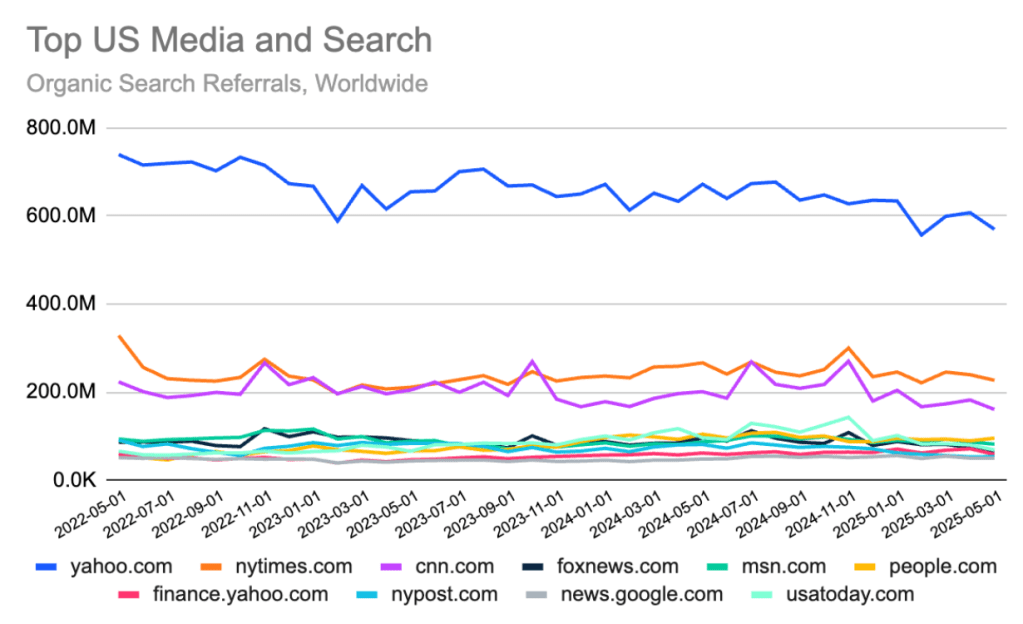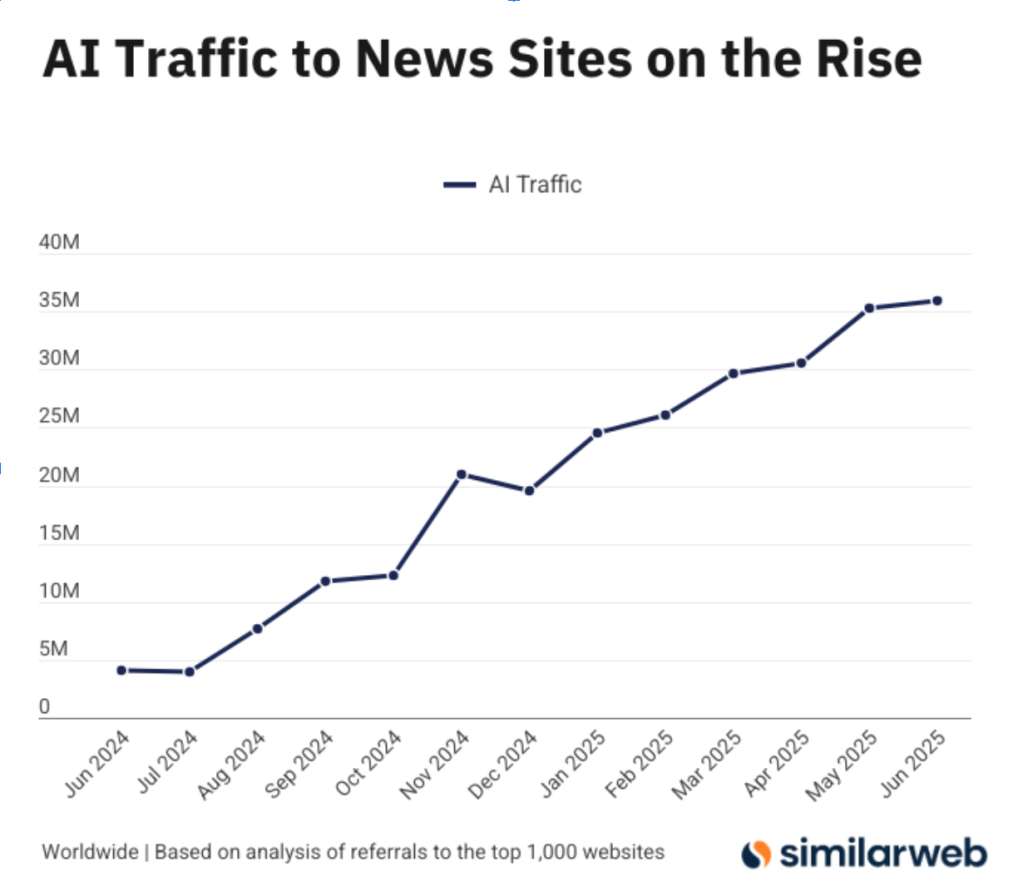In Graphic Detail: AI platforms are driving more traffic — but not enough to offset ‘zero-click’ search

Two trends are emerging in the world of AI and search: AI platforms are sending more traffic to publishers’ sites, while Google’s AI Overviews is reducing click-throughs across more search queries.
Recent data is helping to show the impact of AI tools and features on the search landscape and on referral traffic. And while it seems the percentage of queries triggering Google’s AI Overviews plateaued last month, “zero-click” searches are still on the rise.
However, the referral traffic from AI platforms like OpenAI’s ChatGPT and Perplexity still isn’t enough to offset the decline in search-driven visits. General search referral traffic to 1,000 web domains dipped from 12 billion global visits in June 2024 to 11.2 billion in June 2025 — about a 6.7% decline year over year, according to data from analytics company Similarweb.
Percentage of queries triggering Google AI Overviews has plateaued
| Month | Percentage of queries with AI Overviews |
| January 2025 | 6.49% |
| February 2025 | 7.64% |
| March 2025 | 13.14% |
| April 2025 | 20.22% |
| May 2025 | 19.88% |
The percentage of Google search queries that show an AI Overview has steadily increased this year. But that number plateaued in May to about 20% of U.S. desktop searches, according to Semrush data shared with Digiday.
Mark Traphagen, vp of product marketing and training at SEO and content optimization platform SEOClarity, said it will be worth watching over time, to see whether the share of AI Overviews holds steady at around 20%. SEOClarity data also shows AI Overviews appeared in about 19% of the over 100 million keywords from U.S. searches keywords it tracked in June 2025.
“At some point this will reach an equilibrium, where Google will see from user behavior and know what queries [AI Overviews] are useful for, and know where users don’t want them to be,” Traphagen said.
Of course, all of this is happening while Google continues to develop its generative AI search experience, AI Mode. “The future is an experience that is much more centered around conversational interactions, [instead of] putting in a query and getting a bunch of links,” Traphagen said.
Google’s AI Overviews slip in search rankings
In May, AI Overviews appeared at the top of U.S. desktop search results 98% of the time, according to seoClarity. But new data shows that AI Overviews appeared first in search rankings 87.6% of the time in June — a 10.4 percentage point drop.
The percentage of AI Overviews showing below that first position increased nearly 600% from May to June of this year, from 0.4% of all AI Overviews to 2.4%, according to Traphagen.
“It’s still a very small amount, but it’s much bigger than it was,” Traphagen said. “This means [publishers] can now outrank an AIO, which is significant.”
However, Traphagen said he could not find a pattern in the types of Google search queries where this was happening, although queries with transactional intent — searches aimed at purchasing a product or service — were moving higher up in Google search rankings.
Google uses aggregated user behavior as a factor in determining organic search results. “If they see over time [users are] ignoring [AI Overviews] or look for something else [with certain search queries], it might get demoted,” Traphagen said.
But zero-click searches are also increasing

Since the U.S. launch of Google’s AI Overviews in May 2024, the number of searches for news that result in no click-throughs to news websites has grown from 56% to nearly 69% by May 2025, according to Similarweb data.
So while Google AI Overviews may not be expanding exponentially this summer — they aren’t appearing in significantly more queries or snagging the top search result spot — but the feature is still cutting into publishers’ click-through rates.
It’s important to take all of this data with a grain (or a tablespoon) of salt. The environment is shifting so rapidly that one month’s trend may be next month’s old news. “A one-month change may not necessarily signify that much,” said David Carr, senior insights manager at Similarweb.
Organic search referral traffic has also declined, from over 2.3 billion U.S. visits in July 2024 to 1.8 billion in June this year, per Similarweb.
Some publishers have been hit harder than others. Sites like Daily Mail and People were among the hardest hit by the arrival of Google AI Overviews. Of the top 100 search keywords driving traffic to People’s site, 40 triggered AI Overviews in May 2025. That number was 32 for the Daily Mail, 21 for The Washington Post and 20 for the New York Post.
But the real impact is the percentage of those keywords that triggered AI Overviews and resulted in no click-throughs to a publisher’s site. For some, the percentage of “zero clicks” has grown since AI Overviews was rolled out on Google search.
For example, 75% of the top 100 search keywords driving traffic to CBS News’ site that triggered an AI Overviews resulted in no click-throughs to its site in May 2025, compared to 54% of searches with no click-throughs when looking at the site’s top 100 search terms. That’s a 21% difference in percentage points, according to Similarweb.
Yahoo News had a 20% percentage point difference (with 75.1% of AI Overviews keywords triggering no click-throughs), and a 17% difference for Substack.
For People, the percentage of zero clicks from AI Overviews keywords was 71.2%. And it was 69% for MSN and Google News.
AI referral traffic to news publishers’ sites continues to grow

Another trend that hasn’t changed — at least according to recent data — is that AI referral traffic to publishers’ sites continues to grow.
AI referral traffic to news and media sites from AI platforms other than Google grew from 35.3 million global visits in May 2025 to 35.9 million in June (and grew 5.6 million in May to 6.1 million in June, in the U.S.), according to Similarweb data shared with Digiday.
The bulk of that global traffic in June went to Yahoo (2.3 million), Reuters (1.8 million), the Guardian (1.7 million) and Business Insider (1 million), according to Similarweb. Referral traffic was primarily driven by ChatGPT, followed by Perplexity.
Digiday reported in May that referral traffic from ChatGPT to publishers’ sites had doubled this year (even if the volume of traffic was small).
ChatGPT still the AI platform sending the bulk of referrals to publishers
OpenAI’s ChatGPT is the biggest referral channel for publishers, when looking at AI platforms.
For example, ChatGPT referrals made up 78.5% of the total AI referral traffic that Yahoo received in June. ChatGPT referrals made up 95.4% of Reuters’ total AI referral traffic, 99.4% of the Guardian’s AI referrals traffic, and 95.9% of Business Insider’s traffic.
ChatGPT sent 396.8 million referral visits to 1,000 sites in Similarweb’s data set, representing 81.7% of the AI traffic that went to those sites in June 2025.
More than one-third of the US population now uses generative AI
At the root of all of this data is the fact that more people are using generative AI tools.
According to eMarketer’s latest forecast on AI, more than 120 million Americans will use the technology by the end of the year. More than 35% of the total U.S. population is using generative AI in 2025.
Companies like Apple and Samsung integrated generative AI technology into their software. Google is adding its Gemini chatbot to Android smartphones, and Workspace, which includes applications like Gmail, Google Drive, Docs and Meet.
OpenAI’s ChatGPT is the most widely used generative AI platform, with 88.6 million U.S. users in 2025, according to eMarketer’s data. Google Gemini, meanwhile, is the fastest-growing competitor to ChatGPT. Its share of total generative AI users more than tripled between 2023 and 2025, rising from 16.9% to 46%.
The increase in the adoption of generative AI tools is driven by young people. This year, the 18–24 age segment currently shows a 55% generative AI internet penetration, closely trailed by 25–34 (older Gen Z/younger millennials) at 55.2%, according to the eMarketer data.
Dave Maney, founder and CEO of The Expert Press, said, “I don’t think this wave can be stopped or turned back.”
More in Media

Media Briefing: The top trends in the media industry for 2025
This week’s Media Briefing takes a look at the top trends from 2025, from digital advertising revenue performance to AI licensing deals.

Digiday Scorecard: Publishers rate Big Tech’s AI licensing deals
Digiday has compiled a scorecard grading AI platforms to make sense of the growing number of players in the AI content licensing market.

Publishers are hunting for AI prompt data — now they’re starting to get it from third-party companies
Publishers are finally gaining some visibility into AI search, as new prompt data tools crack open a black box.








